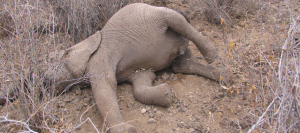One of Africa’s best-studied elephant populations reveals the disturbing impacts of poaching

PHOTO CREDIT: © STE
Press Release
The devastating impacts of a recent surge in ivory poaching have been chronicled in detail by new research on one of Africa’s best-studied elephant populations.
Almost a thousand elephants in Samburu, Northern Kenya, have been closely monitored over the last decade and a half. Over the last four years demand for their tusks has disrupted their close-knit society.
The illegal killing of elephants is increasing rapidly across the continent as the price of ivory has soared. Massacres in Central Africa’s National Parks last year are now being echoed elsewhere in Kenya, including a well-publicised incident in Tsavo National Park on January 4th 2013.
Research conducted by Save the Elephants (STE), a Kenya-based conservation organisation, gives the first detailed analysis of the impacts of illegal killing on a well-studied population. It is published today in the journal PLOS One.
“Unfortunately, illegal killing and related population decline is increasingly common across Africa, therefore the results from this study are directly relevant to understanding the conservation status of this species,” said Dr George Wittemeyer of the University of Colorado and STE, who led the study.
The fate of 509 females and 425 males inside two adjacent national reserves, Samburu and Buffalo Springs, was studied over 14 years. Elephants roam far beyond the safety of the reserves and into danger zones where ivory poachers are active. At the start of the research the population was increasing but in 2009 the poaching of these individually-known elephants began to take its toll. This change gave researchers an unprecedented opportunity to investigate the effects of the killing by comparing times of stability with times of strife.
The proportion of elephants that were illegally killed doubled in the last three years of the study. By 2011, 56 per cent were dying at the hands of poachers.
Older animals – usually those with larger tusks – fared particularly badly. In 2000 there were 38 known males over 30 years old. By 2011 this number had dropped to 12, of whom 7 had grown into the older age class. Almost half of the known females over 30 years old were lost between 2006 and 2011, their number dropping from 59 to 32. While some of this mortality was due to a severe drought that hit the area in 2009-10, at least half is thought to be due to illegal killing.
The wave of killing altered the age structure and age-related social organisation. In 1998 42 per cent of the population was male, but by 2011 the bulls – who bear more ivory – made up only 32 per cent. Ten of the fifty elephant groups were effectively wiped out, with no known breeding females left, while thirteen had no breeding female over the age of 25.
“This represents the destruction of elephant memory banks, and when these are destroyed the survival of those remaining is lowered,” said Dr Iain Douglas-Hamilton, founder of Save the Elephants.
With the loss of numerous well known and stable family groups came increased numbers of unaffiliated juveniles (orphans). Those who were under the age of two when they lost their mother all died. Older survivors adopted a number of different strategies, either remaining solitary, teaming up with other orphans, or joining another group.
The elephants of Samburu responded to the poaching pressure by increasing their reproductive efforts and producing more babies, displaying the resilience that saw them survive the last onslaught on their populations in the 1970s and 80s. The Kenya Wildlife Service working hand-in-glove with local community conservancies have put their lives on the line to defend the animals. Until the price of ivory soared they were prevailing.
“Ivory demand and prices have reached a point at which poachers are willing to target well-protected, closely monitored populations,” said Dr Douglas-Hamilton. “This is now being replicated in other protected areas across Africa.”
“All is not lost, however. We faced this threat thirty years ago and we know that this situation can be controlled and reversed if the appetite for ivory is reduced. There needs to be united action from concerned individuals, NGOs and governments to reduce the demand for ivory.”
—
NOTES FOR EDITORS:
1) In a 2011 piece http://www.nature.com/nature/journal/v476/n7360/full/476282c.html in the journal Nature, STE warned that elephants in well-protected areas were being killed. This paper gives substance to these claims, and the predictions have been borne out by the results of a recent aerial census of Northern Kenya’s elephants by the Kenya Wildlife Service.
2) A portal to information on the continental elephant picture can be found at www.elephantsinperil.org
3) Ivory poaching has taken a new turn thanks to the involvement of organised crime. The involvement of militias such as the Janjaweed, the Lords Resistance Army and Somalia’s Al Shabaab who are funding their operations with ivory has been extensively documented by Jeffery Gettleman of the New York Times, and others.
4) Further research by STE is now investigating, among other things, the fate of orphaned elephants in the wild.
5) A copy of the research paper is attached and can be found online athttp://dx.plos.org/10.1371/journal.pone.0053726.
6) To arrange an interview email [email protected] (lead author) or [email protected] (founder of STE)

